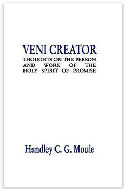Septuagint
The Septuagint
Sometime between the 4th and the 1st century BCE, Jewish scholars, in an attempt to broaden the reach of the Jewish Bible, translated the bible into Greek, producing the_Septuagint. Due both to the process of translation as well as the source material, this translation resulted in extra books being added to the canon which are not generally recognized by Orthodox Jews or Protestant Christian Churches. The Septuagint is one of the main sources for the Greek authors of the New Testament.
The_Septuagint, not the Hebrew texts used by Judaism and modern Christian Bible translators, is still the official form of the Old Testament as used by most of eastern Christianity.

Moule Veni Creati is an old, well known work in studies in the Holy Spirit by Bishop (Anglican) H.G.C. Moule. It has 12 chapters. It is a deep treatment of the Holy Spirit. Although Moule was Anglican, his writings are well written and good.
Downloads:
theWord: Moule Veni Creati
MySword: Moule Veni Creati
ESword:Moule Veni Creati
Adobe Acrobat PDF: Moule Veni Creati
In Jewish tradition (and in the Talmud) the Rabbis translated the Torah, the five books of Moses, and the other books were translated by others. This led to the incorrect translation in Isaiah 7:14 of “עלמה” (“almah”) to “virgin”.
taken from rationalwiki.org/wiki/Guide_to_Bible_translations
The Septuagint has a very important position in the matter of early transcripts mostly because this is the Greek version that Jesus and his followers used as a rule (though sometimes they did break with the LXX and directly translated from the Hebrew, and at other times they used a translation that scholars are just not sure where they got it from).
–DCox
See https://en.wikipedia.org/wiki/Septuagint
Advertisement

Torrey How to Bring Men to Christ is a manual for witnessing to the unsaved to lead them to Christ. It has hints, tips, and suggestions. 13 Chapters.
Downloads:
PDF: Torrey How to bring men to Christ
theWord: Torrey How to bring men to Christ
MySword: Torrey How to bring men to Christ
eSword: Torrey How to bring men to Christ
